February 3 - 9, 2013: Issue 96
The Helen B Stirling Ship's Wheel at Club Palm Beach
In the foyer of Club Palm Beach is the large ship's wheel of the six-masted schooner the Helen B Stirling (sometimes spelt 'Sterling'). The wheel was donated by Carl Gow, Palm Beach RSL founding member and brother of former lighthouse keeper at Barrenjoey, David Gow 1912 – 1919 and son of Robert Gow, who also served at Barrenjoey during WWI.
Carl served at Gallipoli and in France during WWI, returning an honorary Captain to Palm Beach to set up a store with fellow veteran Reginald Augustus Howlett, as well as work as a fisherman, boat hire shed and rescue others from the Gow's - Gonsalves boatshed still in existence just north of the Palm Beach ferry wharf. In fact, the first 'Palm Beach RSL' commenced in the Gow-Gonsalves shed itself.
The wheel is significant in that the saving of the crew of the first Helen B Stirling, a four-masted ship, in January 1922 is credited to the radio operator work of Raymond Shaw during the formative years of radio in Australia and one of the first instances the use of this 'new' technology that has become a standard piece of safety equipment since.
Mr. Shaw was offered a position in The Wireless Shop, founded by Florence Violet McKenzie (nee Wallace), Australia's first female electrical engineer, who would later establish the Women's Emergency Signalling Corps (WESC) in her Clarence Street rooms, the forerunner of the WRANS which would draw its membership from young women such as Mona Vale's Gwyneth Sneesby.
According to the RAN records, on January 21st 1922 HMAS Melbourne, (light cruiser), rescued the crew of 22 of the four-masted schooner Helen B Stirling north of Newcastle, NSW. Other records state the rescue took place on January 25th 1922, although she had already been abandoned and was drifting, still afloat, prior to then, and most Readers would be aware of the ships logs the RAN kept and keeps still.
The papers of the past inform us:
Shipping Menace.
HELEN B. STIRLING DERELICT.
SYDNEY, Monday-A Suva message says that the Helen B. Stirling wreck has drifted off the reef at Middleton reef and across the lagoon. It is feared that the wreck, which is upside down, but very buoyant, will reach the open sea and prove a serious menace to shipping.Shipping Menace. (1923, January 23). Advocate (Burnie, Tas. : 1890 - 1954), p. 5. Retrieved from http://nla.gov.au/nla.news-article69820327
HELEN- B. STIRLING AFLOAT
Melbourne Jan, 25.
The Commonwealth Navigation Service has been advised by cable message from the Marine Department, Wellington, N.Z., that tho schooner Helen B. Stirling, which was abandoned on Monday and the crew of which was rescued by the cruiser Melbourne, was still afloat when last sighted in a position 30 deg. 55 min. south and. 168 deg. 50 min. east, and was drifting westward at the rate of one mile per hour. The vessel, it is stated, was in deep water, but might remain afloat for some time, being upright, with the three masts standing. The position mentioned is approximately 280 deg. north. 42 deg. west true from the Three Kings, N.Z., and is in the track of steamers trading between Queensland and the northern ports of New Zealand. The locality is also frequented by .schooners and other sailing craft. Action has been taken, to warn the shipping concerned.HELEN B. STIRLING AFLOAT (1922, January 26). Kalgoorlie Miner (WA : 1895 - 1954), p. 3. Retrieved from http://nla.gov.au/nla.news-article93261929
HELEN B. STERLING. AFLOAT AND ADRIFT. Melbourne, Wednesday Night.— Cable advice reports, that the abandoned Helen B. Sterling is still afloat and drifting. HELEN B. STERLING. (1922, January 26). Zeehan and Dundas Herald (Tas. : 1890 - 1922), p. 3. Retrieved from http://nla.gov.au/nla.news-article84509225
Helen B. Stirling
Shaw's M.S. for Mitchell Library
During the week the £50 manuscript of Wireless. Operator Raymond Shaw's graphic story of the Helen B. Stirling rescue was offered to and gratefully accepted by the Mitchell Library as a gift from "Smith's Weekly." The boyish operator's first-hand record of heroism and endurance which thrilled "Smith's Weekly" readers will not be the least of the literary treasures housed In the Mitchell. Helen B. Stirling (1922, February 25). Smith's Weekly (Sydney, NSW : 1919 - 1950), p. 13. Retrieved from http://nla.gov.au/nla.news-article234274985
The Helen B. Stirling
PRESENTATIONS TO RESCUERS.
SYDNEY, Tuesday.
Presentations were made to-day by the Governor-General (Lord Forster) to Captain Feakes and seven members of the crew of tile Australian cruiser Melbourne of testimonials from the Government of the United States in recognition of their heroic services in rescuing the master and crew of the shipwrecked American schooner Helen B. Stirling in January of last year.
The presentation took place on the quarter-deck of the Melbourne, in the presence of the Consul for America (Mr. R. Wornmuth), Commodore Addison (Commander of the Australian Fleet), and officers and members of the crew of the Melbourne. Captain, Feakes received a pair of binoculars, and Able-Seamen Duncan, Baker, Fryer, Gibbs, Jameson, Marsh, and Wood each a gold medal. The front of the medal bore the words "Presented by the President of the United States." On the obverse side was the inscription, "In recognition of his heroic service in effecting the rescue at sea on January 25, 1922, of the master and crew of the American schooner Helen B. Stirling."
In making the presentations, Lord Forster traced the story of the rescue. He said that the Melbourne was shaping her course for New Zealand, and was endeavouring to avoid a heavy storm, of which she had warning, when suddenly from the heart of that storm came the signal for help. "We shall not easily forget the way this ship raced into the very heart of the storm," continued the Governor-General, "and, having found the ship that required assistance, carried out the hazardous work of rescue. I congratulate you on the opportunity that came your way, and upon the way in which you responded to It. The Royal Navy and the Royal Australian Navy, at all times endeavoured to act up to the spirit of that fine prayer which so often rises from this quarter-deck, in which you pray "that. we may be safeguards unto our Most Gracious Sovereign Lord, King George and his dominions, and security for such as pass on the seas upon their lawful occasions."
Lord Forster read a letter from the American Ambassador to the British Foreign Secretary as follows:-
"In appreciation of the humane services performed by them in rescuing the master and crew of the shipwrecked American schooner Helen B. Stirling, the President of the United States desires to present testimonials to certain officers and members of the crew of H.M.A.S. Melbourne. In the list of persons whom the President desires to honour for their participation in the rescue was the late Rear-Admiral Dumaresq, to whom the President was desirous of presenting a gold watch and chain. These were transmitted to the British Government, who disposed of them to the relatives of Admiral Dumaresq. I need hardly add that it gives me great pleasure to express the thanks of the Government of the United States to the Royal Australian Navy for the heroic' work of rescue. performed in accordance with the best traditions of the navy from which It sprang." The Helen B. Stirling (1923, June 6). Examiner (Launceston, Tas. : 1900 - 1954), p. 7 (DAILY). Retrieved from http://nla.gov.au/nla.news-article51230614
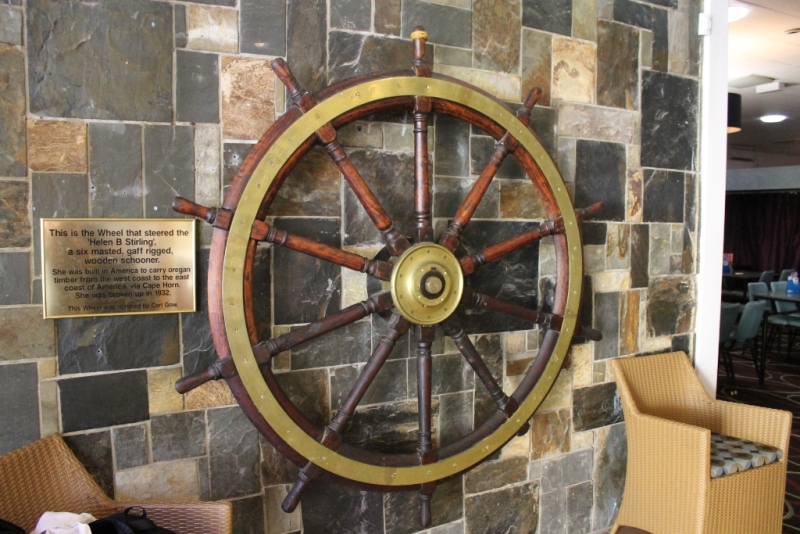
This wheel with ten spokes makes it one of the larger versions of ship’s wheels;
A traditional ship's wheel is composed of eight cylindrical wooden spokes (though sometimes as few as six or as many as ten) shaped like balusters and all joined at a central wooden hub or nave (sometimes covered with a brass nave plate) which housed the axle. The square hole at the center of the hub through which the axle ran is called a drive square and was often lined with a brass plate (and therefore called a brass boss) which was frequently etched with the name of the wheel's manufacturer. The outer rim is composed of four sections each made up of stacks of three felloes, the facing felloe, the middle felloe, and the after felloe. Because each group of three felloes at one time made up a quarter of the distance around the rim, the entire outer wooden wheel was sometimes called the quadrant. Each spoke ran through the middle felloe creating a series of handles on the outside of the wheel's rim. One of these handles/ spokes was frequently given extra grooves at its tip which could be felt by a helmsman steering in the dark and used by him to determine the exact position of the rudder— this was the king spoke and when it pointed straight upward the rudder was dead straight. The wood used in construction of this type of wheel was most often either teak or mahogany. Ship's wheel. (2013, January 21). In Wikipedia, The Free Encyclopedia. Retrieved from http://en.wikipedia.org/w/index.php?title=Ship%27s_wheel&oldid=534097784

The first four-masted Helen B Sterling, courtesy State Library of Victoria. Item FL16148312. Photographer: Green, Allan C., 1878-1954
There were two sailing ships of this name. The first was a four mast schooner which foundered in 1922 near Three Kings off New Zealand. This Helen B Sterling was built as a four-mast wooden auxiliary screw schooner, a windjammer, of 1608 tons, and formerly known as the ‘Tacoma’, by the Washington Shipping Corporation in Seattle in 1917. The dimensions of this vessel were: Length: 220 ft. Breadth: 43 ft. Depth: 21 ft. This original Helen B Sterling was wrecked and sunk in this storm which second generation relatives of those who were passengers state was more like a cyclone. (9).
Windjammers were large sailing ships with an iron or for the most part steel hull, built to carry cargo in the late nineteenth and early twentieth century. Windjammers were the grandest of merchant sailing ships, with between three and five large masts and square sails, giving them a characteristic profile. The origin of the name refers to the typical sound that is made by strong winds blowing through (modern) steel rigging and can be traced back to the Dutch language: the verb 'jammeren' can be translated as 'wailing'.

The second six-masted Helen B Stirling, from which this ship's wheel came., courtesy State Library of Victoria, item no: FL15729619 Photographer: Green, Allan C., 1878-1954
The second ship of this name was a six-masted schooner purchased by Ray Milton Sterling (E R Sterling’s son) in 1926 (she was originally the OREGON FIR and was rejigged). She was named after his mother. Her dimensions were approximately 267.0 feet (81.4 m) in length, 46.5 feet (15.3 m) breadth and 25.2 feet (7.7m) depth and she was a 2526-ton (gross) ship, alike her sister ship the Dorothy H Sterling. (3). The Dorothy H was named for Captain E R Sterling’s daughter. Both these vessels were built at Portland, USA, by the Peninsula Shipbuilding Company of Portland, Oregon, USA and were not only the largest of their kind to be built then but also among the most expensive, costing £50,000 to build.
The Sterlings were an American shipping family. Patriarch Captain Edward Robert Sterling, Canadian born, and his wife Helen B Sterling, plied the timber trade between America, Australia and New Zealand. They had three children, Ray Milton Sterling, Ethel Manila Sterling and Dorothy H Sterling. They were E R Sterling & Company Inc. and came into possession of these large schooners after both met with mishaps elsewhere and their repair bills could not be met.
From the Australian National Maritime Museum blog and Flickr pages of August 30th, 2012:
Ray Milton Sterling was born on 20 December 1894 in his parents' native Halifax in Nova Scotia, Canada. On 5 July 1916, Ray Sterling arrived in Sydney with his father on board E R STERLING. At this point, he was listed as 1st Officer.
Son Ray married Ethel May Francis, born on 17 March 1894 in Hamilton, Newcastle NSW, on 17 December 1916 at St Peters Church in her hometown of Hamilton. Two years later, their daughter Margaret Francis Sterling was born on 8 August, and within three months, records indicate that Mrs Sterling sailed to San Francisco with her daughter on the VENTURA. In the US, the couple lived in Seattle, Washington with Ray Sterling's parents, Captain E R Sterling and Helen B Sterling. Ray Sterling was captain of the six-masted barquentine E R STERLING throughout his career following his father's footsteps. E R STERLING was originally built in Belfast in 1883 as a four-masted iron ship LORD WOLSELEY. In 1904 it was renamed EVERETT G GRIGGS and modified into a six-masted barquentine. It was sold and renamed E R STERLING in 1910, and was broken up in 1927.

Picture: A 1925 picture of Ethel May Francis and daughter Margaret Francis beside the E R Sterling wheel; also ten spokes.

Picture: Ethel May Sterling, Margaret Francis Sterling and Captain Ray Milton Sterling on the deck of E R STERLING, 1921-1925
Images Courtesy The Australian National Maritime Museum, Image: 00035539 taken by Samuel J. Hood Studio Collection; ANMM states before he made his way into photojournalism he would take his Folmer & Schwing Graflex camera to Sydney Harbour and make an income from photographing Captains and their families and their ships as portraits and studies of these vessels on Sydney and Newcastle Harbour. He also photographed many Pittwater Regattas once employed by SMH in the 1930's.
The Sterlings did not have possession of the Helen B Stirling for very long:
Helen B Sterling Sold: the six-masted schooner Helen B Sterling has been purchased by Mr W.S Payne, president of the Pacific Export Lumber Company. The vessel is enroute to Australia with a cargo of more then 2, 000,000 feet of lumber. The Helen B Sterling is to be given back her old name, Oregon Fir. She was completed in Portland in 1920. HELEN B. STERLING SOLD. (1928, October 3). The Sydney Morning Herald (NSW : 1842 - 1954), p. 19. Retrieved from http://nla.gov.au/nla.news-article16499012
E R Sterling was forced to sell one of his schooners, Ethel M Sterling (named for daughter in law), because he had not paid for the two 240 horsepower diesel engines he had installed in 1926. They show a time of prosperity that would again be put under serious strain with E R Sterling & Company Inc. being riddled with ongoing ship disasters. In 1927, E R Sterling faced a gale near the Falkland Islands en route from Port Adelaide to Britain. After nine months at sea, the vessel sailed into the Thames in complete disrepair and had lost its chief officer, who had been crushed to death by one of the masts during a hurricane. (2)
In Autumn of 1930 the Helen B Stirling arrived in Sydney:
HELEN B. STIRLING. Arrives in Sydney. Memories of old sea dogs on the water-front yesterday were pleasantly revived when the graceful lines of the six-masted American schooner Helen B. Stirling came into view. Nowadays the entry of a sailer through the Heads excites quite a flutter among the older shipping fraternity, and the curiosity of the rising generation-they are strange visitors, becoming rarer every year or so. It Is three months since a salier, the Finnish barque Penang, entered the port of Sydney and revived memories of not so many years ago when rival tugs set out to search for her and bring her safely to port. The Helen B. Stirling is a vessel of 2500 tons. She brought nearly 3,000,000 feet of timber from Portland, Oregon, after a voyage occupying 78 days. Her skipper, Captain H. H. Oostrerhuis, is a veteran mariner, and holds confident views of the profitable working of sailing vessels. The vessel, he said, had a comfortable voyage across the Pacific. The Helen B. Stirling was towed into port by the St. Olaves to Double Bay, and later she was taken up to Snails Bay to discharge her cargo. HELEN B. STIRLING. (1930, March 28). The Sydney Morning Herald (NSW : 1842 - 1954), p. 11. Retrieved from http://nla.gov.au/nla.news-article16637511
Unfortunately she then ran into trouble with Australia’s Federal Department of Navigation:
DETENTION ORDERED. SCHOONER HELEN B. STIRLING.
DECLARED UNSEAWORTHY.
Following a report by officers of the Federal Department of Navigation that the six-masted American schooner Helen B. Stirling was unseaworthy, the Deputy-Director of Navigation(Captain C. D. Matheson) has Issued a detention order against the vessel. She will not be allowed to leave Sydney until she has been repaired to the satisfaction of the department's surveyors. The Helen B. Stirling, a vessel of 2500 tons, arrived In Sydney on March 27, 76 days out from Portland (Oregon), with 3,000,000 feet of timber. It is stated that the pumps had to be employed during the latter portion of the trip, and that an Inspection by surveyors of the Federal Navigation Department led to a discovery that the vessel was still making water. Captain Oosterhuis, the master, is now awaiting instructions from his principals in Portland. The Helen B. Stirling is moored in Snail's Bay. DETENTION ORDERED. (1930, April 21). The Sydney Morning Herald (NSW : 1842 - 1954), p. 10. Retrieved from http://nla.gov.au/nla.news-article16677245
THE HELEN B. STIRLING. CREW WILLING TO TAKE HER TO SEA.
Whilst the Federal Department of Navigation remains firm in demanding that the six masted American schooner Helen B. Stirling must be repaired before she will be allowed to leave Sydney, the local agents are pressing for the cancellation of the detention order. They admit that she is still making water, but state that the master (Captain Oosterhuis) and crew are prepared to take her to sea. It was stated on behalf of the agents yesterday that a leak had developed early in the 76-day voyage from Portland (Oregon), and that the pumps had been kept In action throughout the rest of the journey. On arrival In Sydney it was found that the vessel was holed, below the waterline. A diver had since descended, and effected repairs, and, although a little water was still finding its way into the hull, it was not thought necessary to undertake the expense of dry-docking the vessel. Advice on that point was being awaited from the owners In Portland. The Department of Navigation, on the other hand, continues to conduct daily tests. It points out that, if disaster should overtake the vessel after she had been allowed to sail from Australia In what it considered an unseaworthy condition, the responsibility would rest with the department. THE HELEN B. STIRLING. (1930, April 23). The Sydney Morning Herald (NSW : 1842 - 1954), p. 14. Retrieved from http://nla.gov.au/nla.news-article16663488
It seems the Great Depression affected those who had bought these large vessels and harbour dues, upkeep fees, repair costs and crew wages resulted in her sister ship, the Dorothy H Sterling being abandoned and ‘seized in South Australia. (3). While in port and moored The Helen B Stirling was put to use in a great way to begin Spring 1930:
DANCE ON SHIPBOARD. A novel entertainment took place last night when a dance was held on board the HelenB. Stirling, an old American sailing vessel, which is lying off Point Piper. The ship was lent for the occasion by the captain, Captain H. Oosterhuis. Motor launches conveyed the guests, who numbered 200, from Fort Macquarie to the ship. The two long decks, each over 210 feet in length, were used for dancing, and were illuminated by petrol lamps. A feature of the evening was the ballet, the members of which were arrayed as pirates,' and boarded the ship late in the evening, and were met with a barrage of coloured streamers and confetti thrown by the dancers. The dance was organised by a number of art students of well-known studios of Sydney, and by University undergraduates. It is proposed to hold another dance on board the ship shortly. DANCE ON SHIPBOARD. (1930, September 10). The Sydney Morning Herald (NSW : 1842 - 1954), p. 6. Retrieved from http://nla.gov.au/nla.news-article16700174
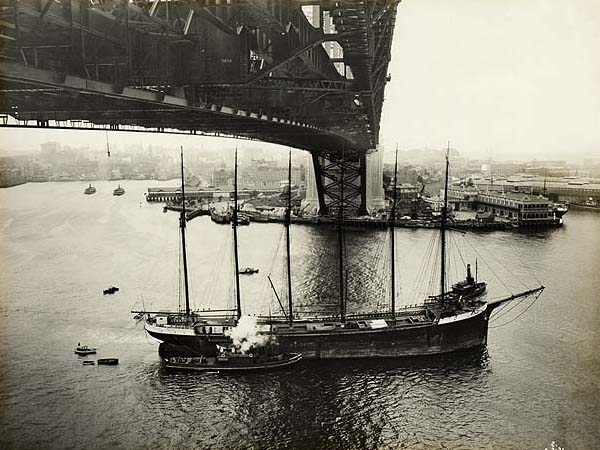 HELEN B. STERLING.
HELEN B. STERLING.
Passing Under Bridge. At 3 o'clock this afternoon the six-masted schooner, Helen B. Stealing, which has lain idle in Rose Bay since early last year, when the navigation authorities declared her unseaworthy, will pass under the Harbour Bridge in tow, on her way to Kerosene Bay, to join many other old-timers in "The Bay of Forgotten Ships."
The event is particularly interesting, in view of the fact that the schooner's six masts are more than 170ft in height. On a high tide, therefore, it is doubtful whether there would have been sufficient clearance for the schooner to pass under the bridge deck. For this reason she will be towed to her new quarters at low tide. When the owners were refused permission to take the Helen B. Sterling to sea, It was ruled that, if proper repairs were effected, a seaworthy certificate would be issued. No steps were taken to fulfil the department's requirements, and, as the schooner was thought to be obstructing traffic, she must seek a more out of-the-way resting place. HELEN B. STERLING. (1931, March 5). The Sydney Morning Herald (NSW : 1842 - 1954), p. 8. Retrieved from http://nla.gov.au/nla.news-article16759181
Some sources state the Helen B. Stirling may have been used as a ‘test vehicle’ for all ships passing under the then not yet finished Sydney Harbour Bridge and as she was moved at low tide, with a clearance of only five feet, this may well have been the case, as illustrated in this photo from the Argus, taken by Sam Hood (there are also copies of these pictures in the NSW State Records):
NARROW CLEARANCE. (1931, March 7). The Argus(Melbourne, Vic. : 1848 - 1956), p. 17. Retrieved February 1, 2013, from http://nla.gov.au/nla.news-article4376744
Once moved to Kerosene Bay it seems more likely that she was dismantled and sold off. Parts of many old ships were incorporated into wharves and used as pylons on waterfronts all over Australia.
Sydney Morning Herald – February 8, 2008. In Column 8 – From Ric Havyatt, of Woolwich.
“In 1930 she (Helen B) was moored off Point Piper, and several times my brothers and I rowed out to the ship and went aboard with the permission of the caretaker. The holds contained large river boulders as ballast, and plenty of rats. When the ship was finally broken up, two of its masts were erected on Middle Head to hold the transmitting aerial for radio station 2KY.”
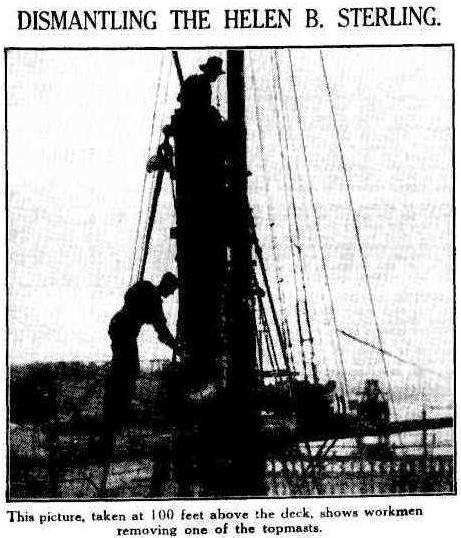
DISMANTLING THE HELEN B. STERLING. This picture, taken at 100 feet above the deck, shows workmen removing one of the topmasts. DISMANTLING THE HELEN B. STERLING. (1933, April 4). The Sydney Morning Herald (NSW : 1842 - 1954), p. 12. Retrieved from http://nla.gov.au/nla.news-article16963097
She was further broken up and used as firewood. Elsewhere when this was the case in 1933, which was one of the worst year for people in Australia during the Depression, old ships and their wood were given to people in need during a cold winter:
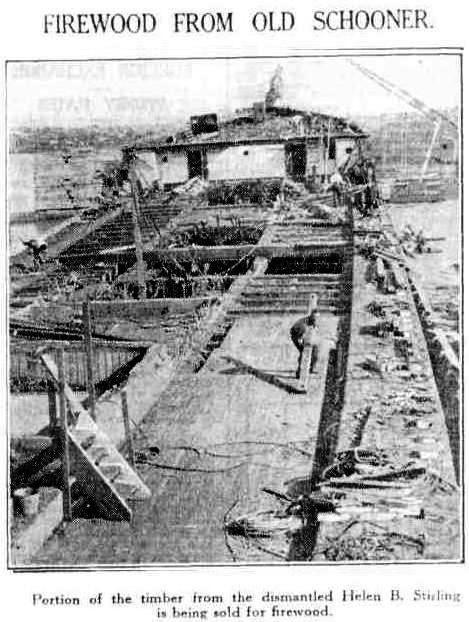
FIREWOOD FROM OLD SCHOONER. (1933, June 20). The Sydney Morning Herald (NSW : 1842 - 1954), p. 12. Retrieved from http://nla.gov.au/nla.news-article16968970
Her hulk stayed in then named Kerosene Bay until March 1934. It is not stated whether she was deliberately burnt, as Kerosene bay was a ‘graveyard’ for old ships where they were dismantled then burnt to the waterline, or whether this fire was an accident;
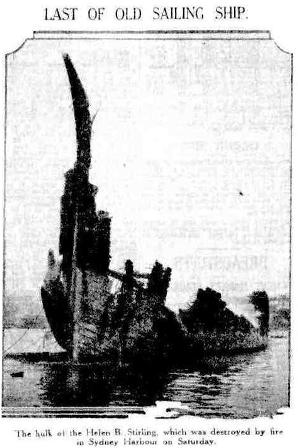
LAST OF OLD SAILING SHIP. (1934, March 26). The Sydney Morning Herald (NSW : 1842 - 1954), p. 14. Retrieved from http://nla.gov.au/nla.news-article17065501
The other sad note to this story is that her Captain refused to leave her while she lay marooned in Sydney harbour and waited for two years for her to be repaired before relinquishing all hope and moving on:
FORMER MASTER OF HELEN B STERLING- News was received at Sydney yesterday that Captain H H Oosterhuis formerly master of the now abandoned six-masted schooner Helen B Sterling, had rejoined the United States four-masted schooner Sophie Christenson which he at one time commanded as navigating officer. The owner of the vessel Mr J E Shields of Seattle Is master With22 outboard motor boats on board the schooner has left for Alaska where she will remain through-out the cod fishing season Meanwhile the Helen B Sterling has been stripped, and the hulk lies in Berry's Bay. FORMER MASTER OF HELEN B. STERLING. (1933, June 8).The Sydney Morning Herald (NSW : 1842 - 1954), p. 13. Retrieved from http://nla.gov.au/nla.news-article16981281
The Gow family, as seen in 'The Fearless Men Of Palm Beach SLSC's Surf Boats First Crews - A Tale of Viking Ships, Butcher Boats and Robert Gow’s Tom Thumb 'Canoe', had a long association with Newcastle, as well as going out in storms to the aid of those in peril on the sea from Palm Beach. The passion for all things nautical also extended to collecting items such as these - a passion the Gonsalves family also had.
Fortunately and thanks to Carl Gow, and the Palm Beach RSL, Pittwater people and visitors can look at and touch this wheel from Maritime History and be in the presence of those who sailed in her and the times of prosperity that were cut short by the fiscal strangling the Great Depression was for so many sea-faring entrepreneurs.
Helen B Sterling references and extras
- Carl Gow’s WWI Service in AIF
- Palm Beach Jetty - Gow's Wharf
- Carl Gow’s WWI Service in AIF
- Carl Gow and Frank Gonsalves Boatshed, Palm Beach
- Palm Beach Link With 1817 and 1917 Set to Disappear in 2017: Beach Road Rendezvous
- The Fearless Men of Palm Beach SLSC's Surf Boats First Crews - A Tale of Viking Ships, Butcher Boats and Robert Gow's Tom Thumb 'Canoe
- Light Keepers of Barrenjoey Lightstation
- Peter Frederick Verrills
- Retrieved from: http://kiwitrevau2.tripod.com/id18.html
- A Sterling day out with the family. HMB Endeavour website. Published Date : Wed, 29 Aug 2012 by Nicole Cama
- Curatorial assistant. Retrieved from http://endeavour.anmm.gov.au/Keep-Up-to-date/Ships-blog/5/2012_08_30_a-sterling-day-out-with-the-family
- Dorothy H Sterling. The Schooner Dorothy H Sterling (and other ships associated with her) by Steve Reynolds. Marine Life Society of South Australia. June 2008 Newsletter. Retrieved from: http://www.mlssa.asn.au/cgi-bin/Publications.cgi?topic=nletters/MLSSA_NL_355_June_2008.htm&hash=1
- Nicole Cama. Australian National Maritime Museum Blog. August 30, 2012. Retrieved from; http://anmm.wordpress.com/2012/08/30/a-sterling-day-out-with-the-family/

Above: A schematic animated drawing of the workings of a traditional ship's wheel and tiller showing a series of pulleys and sheaves. Created by and courtesy of KDS444 November 2012.
The steering gear of earlier ships sometimes consisted of a double wheel where each wheel was connected to the other with a wooden spindle that ran through a barrel or drum. The spindle was held up by two pedestals that rested on a wooden platform, often no more than a grate. A tiller rope orchain (sometimes called a steering rope or chain) ran around the barrel in five or six loops and then down through two tiller rope slots at the top of the platform before connecting to two sheaves just below deck (one on either side of the ship's wheel) and thence out to a pair of pulleys before coming back together at the tiller and therefore the ships rudder. Movement of the wheels (which were connected and moved simultaneously) caused the tiller rope to wind in one of two directions and shifted the tiller left or right. In a typical and intuitive arrangement, a helmsman turning the wheel counterclockwise would cause the tiller to move to starboard and therefore the rudder to swing to port causing the vessel to also turn to port (see animation). Ship's wheel. (2013, January 21). In Wikipedia, The Free Encyclopedia. Retrieved from http://en.wikipedia.org/w/index.php?title=Ship%27s_wheel&oldid=534097784
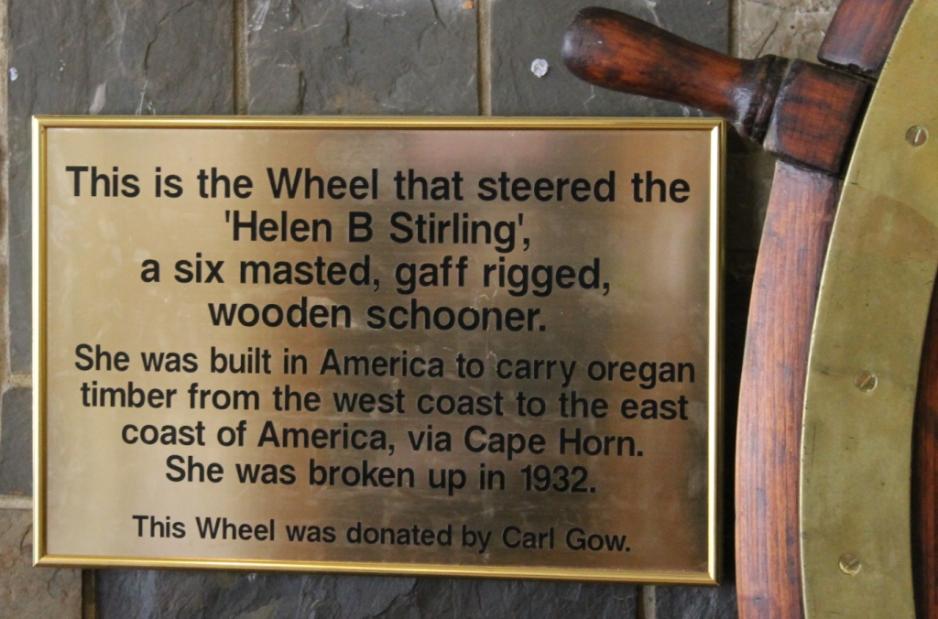
Helen B Stirling Wheel at Palm Beach RSL by A J Guesdon, 2013.